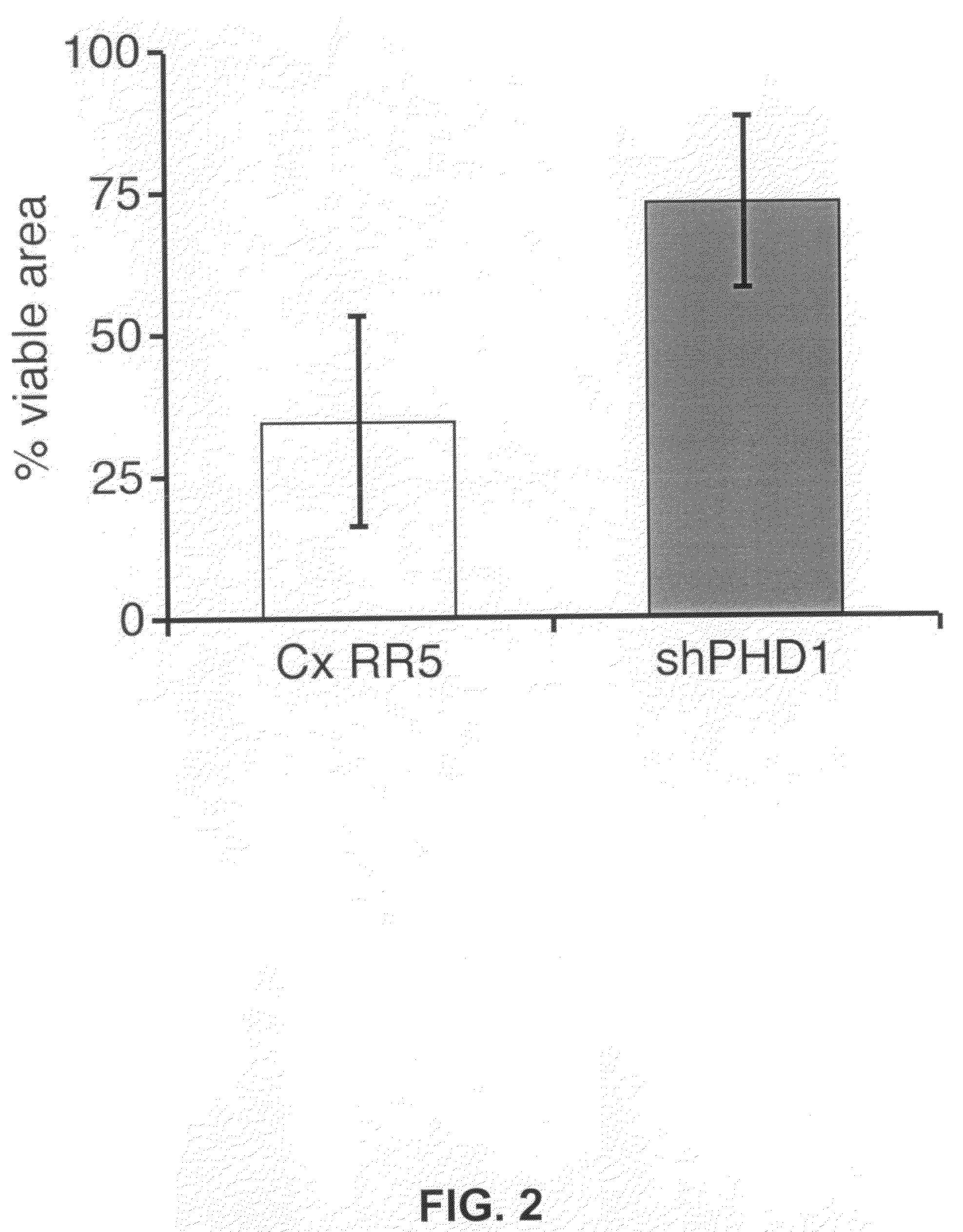[0023]Beside the inhibition of translation, the anti-sense oligonucleotide sequences can work through the use of RNA inhibition (RNAi) with the invention applying anti-sense oligonucleotides that are specifically directed to the sequence that encodes PHD-1 and forms a siRNA duplex. RNAi is based on the degradation of particular target sequences by the design of short interference RNA oligos (siRNA) that recognize the target sequence and subsequently trigger their degradation by a poorly understood pathway. The siRNA duplexes should preferentially be shorter than 30 nucleotides, because longer stretches of dsRNA can activate the PKR pathway in mammalian cells, which results in a global a-specific shut-down of protein synthesis. Target regions should be AA(N19)TT or AA(N21), should be specific for the gene of interest and should have a GC content of approximately 50%. The siRNAs duplexes can, for example, be transfected in the cells of interest by oligofectamin (Life Technologies) and the transfection efficiency reaches 90-95%.
[0025]An LNA-modified oligonucleotide contains one or more units of an LNA monomer, preferably one or more 2′-O, 4′-C-methylene bridge monomers (oxy-LNA), see WO9914220. Incorporation of LNA monomers containing a 2′-O, 4′-C-methylene bridge into an oligonucleotide sequence leads to an improvement in the hybridization stability of the modified oligonucleotide. Oligonucleotides comprising the 2′-O, 4′-C-methylene bridge (LNA) monomers and also the corresponding 2′-thio-LNA (thio-LNA), 2′-HN-LNA (amino-LNA), and 2′-N(R)-LNA (amino-R-LNA) analogue, form duplexes with complementary DNA and RNA with thermal stabilities not previously observed for bi- and tricyclic nucleosides modified oligonucleotides.
[0026]The increase in Tm per modification varies from +3 to +11 degree Celsius, and furthermore, the selectivity is also improved. An LNA-modified oligonucleotide may contain other LNA units in addition to or in place of an oxy-LNA group. In particular, preferred additional LNA units include 2′-thio-LNA (thio-LNA), 2′-HN-LNA (amino-LNA), and 2′-N(R)-LNA (amino-R-LNA)) monomers in either the D-beta or L-alpha configurations or combinations thereof. An LNA-modified oligonucleotide may also have internucleoside linkages other than the native phosphodiester, e.g., phosphoromonothioate, phosphorodithioate, and methylphosphonate linkages. The LNA-modified oligonucleotide can be fully modified with LNA (i.e., each nucleotide is an LNA unit), but it is generally preferred that the LNA-modified oligomers will contain other residues such as native DNA monomers, phosphoromonothioate monomers, methylphosphonate monomers or analogs thereof. In general, an LNA-modified oligonucleotide will contain at least about 5, 10, 15 or 20 percent LNA units, based on total nucleotides of the oligonucleotide, more typically at least about 20, 25, 30, 40, 50, 60, 70, 80 or 90 percent LNA units, based on total bases of the oligonucleotide.
[0058]In certain embodiments, a non-human, transgenic animal comprising a targeting vector that further comprises recombination sites (e.g., Lox sites, FRT sites) can be crossed with a non-human, transgenic animal comprising a recombinase (e.g., Cre recombinase, FLP recombinase) under control of a particular promoter. It has been shown that these site-specific recombination systems, although of microbial origin for the majority, function in higher eukaryotes, such as plants, insects and mice. Among the site-specific recombination systems commonly used, there may be mentioned the Cre / Lox and FLP / FRT systems. The strategy normally used consists of inserting the loxP (or FRT) sites into the chromosomes of ES cells by homologous recombination, or by conventional transgenesis, and then of delivering Cre (or FLP) for the latter to catalyze the recombination reaction. The recombination between the two loxP (or FRT) sites may be obtained in ES cells or in fertilized eggs by transient expression of Cre or using a Cre transgenic mouse. Such a strategy of somatic mutagenesis allows a spatial control of the recombination because the expression of the recombinase is controlled by a promoter specific for a given tissue or for a given cell.
[0059]A second strategy consists in controlling the expression of recombinases over time so as to allow temporal control of somatic recombination. To do this, the expression of the recombinases is controlled by inducible promoters such as the interferon-inducible promoter, for example. The coupling of the tetracycline-inducible expression system with the site-specific recombinase system described in WO 94 / 04672 has made it possible to develop a system for somatic modification of the genome, which is controlled spatiotemporally. Such a system is based on the activation or repression, by tetracycline, of the promoter controlling the expression of the recombinase gene. It has been possible to envisage a new strategy following the development of chimeric recombinases selectively activated by the natural ligand for the estrogen receptor. Indeed, the observation that the activity of numerous proteins, including at least two enzymes (the tyrosine kinases c-abl and src), is controlled by estrogens, when the latter is linked to the ligand-binding domain (LBD) of the estrogen receptor alpha, has made it possible to develop strategies for spatiotemporally controlled site-specific recombination. The feasibility of the site-specific somatic recombination activated by an anti-estrogenic ligand has thus been demonstrated for “reporter” DNA sequences in mice and, in particular, in various transgenic mouse lines that express the fusion protein Cre-ERT activated by Tamoxifen. The feasibility of the site-specific recombination activated by a ligand for a gene present in its natural chromatin environment has been demonstrated in mice.
 Login to View More
Login to View More 

